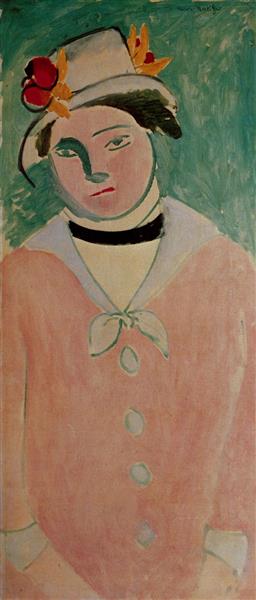Description
Henri Matisse, a fundamental pillar of modern art, presents in "Marguerite with Hat" (1914) a complex amalgam of emotions and technique that deserve careful contemplation. This portrait of his daughter Marguerite encapsulates the artist's evolution towards a more refined and expressive visual language that marked one of the most fruitful stages of his career.
The image of Marguerite is manifested with a wide, dark hat that frames her face in an almost monochromatic composition, predominantly featuring blue and black tones. Matisse's chromatic choice in this work is indicative of his exploration of Fauvism, although here adopted in a more contained and reflective manner. The hat, a voluminous structure, organizes the space and creates a balance between the figure and the background, both delineated with a precision that borders on the schematic.
Marguerite, as the subject of the portrait, offers a serene and absorbed, perhaps introspective, gaze that resonates with the meditative atmosphere Matisse manages to capture. The economy of details in the facial features—a defined nose, barely sketched lips, and the suggestion of eyes—underline a search for essence rather than literalness. This economy is complemented by the highly simplified background, where a few brushstrokes suggest an environment but do not explicitly state it.
Marguerite's posture, clad in a dark mantle, is contemplative. Her figure is slightly inclined to one side, giving the portrait an internal dynamic that challenges the apparent stillness of her expression. The interaction between figure and background in this portrait is crucial: the contrast between the color planes creates a visual vibration that holds the observer's attention and fosters a meditation on form and content.
Henri Matisse, influenced by his classical training and his innovative impetus, achieves in "Marguerite with Hat" a synthesis of both worlds. The work, although careful and precise in its execution, does not avoid its emotional and intimate connections. The portrait is not only a stylistic exercise but a personal statement. It can be inferred that the series of portraits of Marguerite reflect the close and affectionate relationship between father and daughter, adding a layer of meaning that transcends mere visual representation.
By placing "Marguerite with Hat" within the broader context of Matisse's art, connections can be traced with other works by the artist where the human figure and the use of color become tools to explore subjectivity and emotion. Works like "The Romanian Blouse" and "The Lady in Blue" also illustrate this fascination with the face and its expressions, and how a simple change in tone or posture can narrate a completely different story.
In summary, "Marguerite with Hat" from 1914 not only stands out for its balanced composition and deep introspection within Marguerite's figure, but also reaffirms Matisse's ability to synthesize in one work the emotional strength and technical innovation. This piece stands as an enduring testament to the artist's relentless journey to capture the essence of his subjects through a unique and deeply personal lens.

